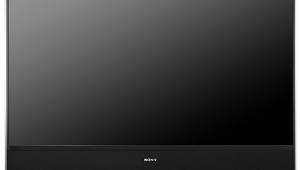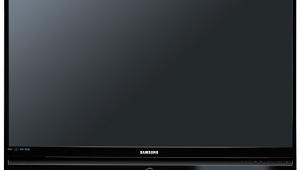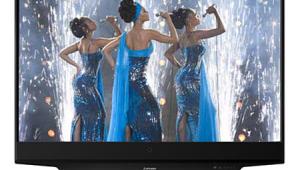Mitsubishi WD-52628 DLP RPTV

There is a lot of confusion swirling around this chip, caused in part by some (deliberately?) murky nomenclature and in part because TI does not release specs on their chips. TI makes two 1080p DLP chips for consumer applications. One, designed for front projectors that are scheduled to hit the market this year, paints a 1920x1080 image on the screen using a 1920x1080 array of discrete mirrors. The other chip is designed for rear-projection TVs such as this Mitsubishi, and it puts 1920x1080 pixels on the screen using a 960x1080 mirror array assisted by a technique variously known as SmoothPicture (as TI would have it), or Wobulation (as inventor Hewlett Packard calls it). This technique horizontally oscillates the mirrors so quickly that the eye effectively sees two pixels for each physical mirror. The result is 1920x1080 pixels on the screen, which is more than double the pixel count of TI's previous 720p DLP chips.
Regardless of how you parse its resolution, the WD-52628 represents a quantum leap in DLP performance. Gone entirely are the bilious greens and weak blacks that marred the earliest DLP models. False contouring and "rainbow" picture artifacts are also greatly reduced. Compared to previous designs such as the Toshiba 52HM94 I reviewed last year, this Mitsubishi limits rainbow sightings to rare, worst-case picture conditions.
TI also claims that the SmoothPicture 1080p chip used here has DarkChip3 technology, which TI says consists of "architectural changes that result in a 20 to 40 percent improvement in contrast" compared to previous designs. Mitsubishi couples the 1080p chip to a proprietary light engine that includes a six-segment color wheel spinning at 10,800 RPM.
Incoming 480i, 480p, 720p, and 1080i video signals are deinterlaced and/or scaled to match the set's 1920x1080 Wobulated array. Mitsubishi calls their unique algorithms that do this "Plush1080p."
The set can receive 1080p/24 and 1080p/30 broadcasts (two of the ATSC broadcast formats, currently unused and unlikely to be). It can also accept these formats via its IEEE 1394 inputs (though it's unlikely we'll ever see programming at these resolutions over such a link). These 1080p formats, should they ever become available, are, however, converted to by the set 1080i for other processing (such as PIP, color adjustments, etc.) then converted back to 1080p prior to being displayed. Bottom line: the Mitsubishi will not accept 1080p sources via component or HDMI, and in any case provides no direct route for any1080p source directly to the display. This limitation is true for most of the 1080p sets presently on the market.
Of course, the inability to handle a 1080p signals from HDMI or component doesn't really matter just yet, because the only 1080p signal sources are a handful of high-end Media Center PCs and upconverting DVD players. HD DVD is spec'd for 1080p output, but the initial releases will be 1080i, according the information we have. Press releases for movies released in Blu-ray have claimed 1080p, but we'll see when we actually get the discs.
Video Inputs
Sitting roughly in the middle of Mitsubishi's line up, the 52-inch WD-52628 ($3899 list) is a well-featured, fully integrated, digital cable-ready HDTV. In other words, it has a built-in ATSC/QAM tuner for receiving DTV/HDTV channels via antenna or cable, a slot for a CableCARD descrambler, and two analog NTSC tuners. The other 52-inch 1080p model in the line is the WD-52627 ($3699), which is the same as the 52628 minus two video processing features that you can probably live without and a different trim strip on the front. You can also get the same chassis with a 62- or 73-inch screen, and these larger screen sizes can be had either with or without a built-in hard-disk video recorder and shiny screen protector.
All of the sets have two HDMI inputs, one of which accepts computer video formats ranging from VGA (640x480) to XGA (1024x768), all at 60Hz. Separate jacks are also provided in case you need to connect stereo audio from a DVI source. (HDMI conveys video and audio over the same cable; DVI is a video-only connection, requiring a separate cable for the accompanying audio that can be connected via HDMI with a simple "breakout" cable.)
Rounding out the rear panel complement is a pair of IEEE 1394 FireWire jacks, along with the usual A/V and S-Video inputs. A third FireWire input appears on the front panel, and hidden behind a front-panel flap is a memory card reader with slots for SmartMedia, MultimediaCard/Secure Digital (SD), Compact Flash I-II/MicroDrive, and Memory Stick.
Analog video inputs include a generous three component-video inputs and two A/V inputs with S-Video. There are two RF cable/antenna inputs.
Video Features and Settings
Most high-end TVs allow you to store independent picture settings for each input. The Mitsubishi takes this one step further: it not only memorizes independent settings for each input, it memorizes two complete sets of adjustments for each input, one labeled "Bright" for daytime viewing and the other "Natural" for dimmer, home-theater environs. This is far superior to the usual "picture presets" found on competing sets.
Rather than the usual color and tint controls, the 52628 has Mitsubishi's PerfectColor function, which provides individual sliders for magenta, red, yellow, green, cyan, and blue. It's easy to go overboard with these controls, but when a judicious tweak to, say, red is required, you can do it with ease.
There are two color temperature settings, labeled High and Low. The former is way too blue, measuring around 12,000K. The latter comes pretty close to the D6500 color temperature spec, actually measuring a bit low out of the box at around 6,000K. See the "Tests and Calibration" section for details.
The two video processing functions that distinguish the 628-series models from the less expensive 627 series are SharpEdge and the DeepField Imager. SharpEdge applies edge enhancement to vertical lines, which sharpens the picture at the expense of white haloes appearing on dark lines, and other artifacts. These are considered unwelcome artifacts by most videophiles, so feel free to leave this "enhancement" off as I did. According to the manual, the DeepField Imager "dynamically enhances black levels in portions of the screen to provide strong contrast with detail over mixed screen content."
I rarely have any use for zoom modes that attempt to expand 4:3 images to fill the full width of a 16:9 wide screen. They simply cause too much geometric distortion to be watchable. The Mitsubishi offers six Display Formats, and as usual, most are all but useless. There is one mode, however, called Stretch that does a pretty good job with simple news shows and the like. My wife calls it the "Jon Stewart mode," because we sometimes use it when watching the Daily Show. There is some obvious stretching visible during the interview segment, when Jon is shown on the right side of the screen and the guest on the left, but most of his guests have pretty fat heads anyway, so some additional stretching is barely noticeable. The Mitsubishi uses black bars to fill in the unused areas at the sides of the screen when showing 4:3 images, which is as it should be. The Toshiba 52HM94 nearly drove me crazy by using obnoxious light-gray bars, which is a deliberate design decision that makes absolutely no sense. The old excuse for using gray bars -- that they are necessary to "exercise" the full width of the CRTs to prevent uneven image wear – is simply not an issue with DLP sets, which are immune to image burn-in.
User Interface
Thanks to a thin screen bezel and a narrow speaker section located below the screen, the WD-52628 presents a sleek, streamlined look when viewed from the front. Overall cabinet depth is 18.5 inches, which is slim compared to an old CRT set, but maybe a tad portly compared to other, similarly sized DLP and LCD sets. Like all modern microdisplay RPTVs, you will need a stand or other furniture to raise the Mitsubishi up to proper viewing height. Finally, there is barely enough horizontal space on top of the set to perch a small center speaker, though I ended up rigging a shelf to accommodate my rather large B&W HTM.
- Log in or register to post comments
























































